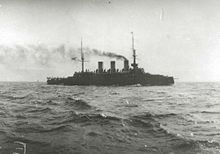Russian battleship Oslyabya
French Tunisia , 1903
| |
| History | |
|---|---|
| Name | Oslyabya |
| Namesake | Rodion Oslyabya |
| Builder | New Admiralty Shipyard, Saint Petersburg |
| Cost | 11,340,000 rubles |
| Laid down | 21 November 1895[Note 1] |
| Launched | 8 November 1898 |
| In service | 1903 |
| Fate | Sunk at the Battle of Tsushima, 27 May 1905 |
| General characteristics | |
| Class and type | Peresvet-class pre-dreadnought battleship |
| Displacement | 14,408 long tons (14,639 t) |
| Length | 434 ft 5 in (132.4 m) |
| Beam | 71 ft 6 in (21.8 m) |
| Draft | 26 ft 3 in (8.0 m) |
| Installed power |
|
| Propulsion | 3 shafts, 3 triple-expansion steam engines |
| Speed | 18 knots (33 km/h; 21 mph) |
| Range | 6,200 nmi (11,500 km; 7,100 mi) at 10 knots (19 km/h; 12 mph) |
| Complement | 27 officers, 744 enlisted men |
| Armament |
|
| Armor | |
Oslyabya (
Design and description
The design of the Peresvet class was inspired by the British second-class battleships of the Centurion class. The British ships were intended to defeat commerce-raiders like the Russian armored cruisers Rossia and Rurik; the Peresvet-class ships were designed to support the Russian cruisers. This role placed a premium on high speed and long range at the expense of heavy armament and armor.[1]
Oslyabya had a length of 434 feet 5 inches (132.4 m)
The ship's
Oslyabya's
Construction and career

Oslyabya, named for
Russo-Japanese War

The Russian strategy since 1897 had been for ships from the Baltic Fleet to be ordered to the Far East if war with Japan broke out, while the First Pacific Squadron in Port Arthur would avoid a general fleet battle until reinforcements arrived. On 15 October 1904, Oslyabya set sail for Port Arthur from
En route, Rozhestvensky reorganized his ships into three tactical
While figures are not available for Oslyabya, one Russian account after the battle said that the Borodinos were approximately 1,700 long tons (1,700 t) overweight as they were overloaded with coal and other supplies that were stored high in the ships, reducing their stability. Oslyabya's main armor belt was fully submerged with a full load, much less any additional coal and supplies, and thus the four-inch-thick upper armor was the only available protection for the ship's waterline.[14]
Battle of Tsushima

The Russians were spotted early on the morning of 27 May by Japanese ships as they entered the
Notes
- ^ All dates used in this article are New Style.
- ^ Neither Forczyk nor McLaughlin provide figures for the number of survivors, while Campbell says that 385 survivors were rescued by Russian destroyers and 514 men went down with the ship. Krestyaninov gives 376 men rescued, but 5 of those were later killed aboard the destroyer Bravii and another 22 aboard the armored cruiser Dmitrii Donskoi.[18][7][17][20]
Footnotes
- ^ McLaughlin, p. 108
- ^ McLaughlin, pp. 107–108, 114
- ^ McLaughlin, pp. 107–108, 112–113
- ^ McLaughlin, pp. 107–108, 113–114
- ^ Silverstone, p. 380
- ^ McLaughlin, pp. 107, 110, 112, 114–115
- ^ a b c Krestyaninov, Movies and death "Oslabya"
- ^ McLaughlin, p. 166
- ^ Forczyk, p. 9
- ^ Schrad, p. 163
- ^ Pleshakov, p. 92
- ^ McLaughlin, p. 167
- ^ Forczyk, pp. 25, 56
- ^ McLaughlin, pp. 114, 167
- ^ Forczyk, pp. 56, 61
- ^ Forczyk, pp. 61–62
- ^ a b Campbell, pp. 128–131
- ^ a b Forczyk, p. 62
- ^ McLaughlin, p. 168
- ^ Taras, p. 28
References
- Campbell, N. J. M. (1978). ISBN 0-87021-976-6.
- Forczyk, Robert (2009). Russian Battleship vs Japanese Battleship, Yellow Sea 1904–05. Oxford, UK: Osprey. ISBN 978-1-84603-330-8.
- Krestyaninov, Vasiliy (1998). "Броненосцы типа "Пересвет" (Battleships of the "Peresvet" class)". Морская коллекция (in Russian) (1). Khimki, Russia: Kollektsiia. OCLC 436873057.
- McLaughlin, Stephen (2003). Russian & Soviet Battleships. Annapolis, Maryland: Naval Institute Press. ISBN 1-55750-481-4.
- Pleshakov, Constatine (2002). The Tsar's Last Armada: The Epic Voyage to the Battle of Tsushima. New York: Basic Books. ISBN 0-465-05791-8.
- Schrad, Mark Lawrence (2014). Vodka Politics: Alcohol, Autocracy, and the Secret History of the Russian State. Oxford, UK: Oxford University Press. ISBN 978-0-19-975559-2.
- Silverstone, Paul H. (1984). Directory of the World's Capital Ships. New York: Hippocrene Books. ISBN 0-88254-979-0.
- Taras, Alexander (2000). Корабли Российского императорского флота 1892–1917 гг [Ships of the Imperial Russian Navy 1892–1917]. Library of Military History (in Russian). Minsk, Russia: Kharvest. ISBN 978-985-433-888-0.
Further reading
- Campbell, N. J. M. (1979). "Russia". In Chesneau, Roger & Kolesnik, Eugene M. (eds.). Conway's All the World's Fighting Ships 1860–1905. New York: Mayflower Books. pp. 170–217. ISBN 0-8317-0302-4.
- Warner, Denis & Warner, Peggy (2002). The Tide at Sunrise: A History of the Russo-Japanese War, 1904–1905 (2nd ed.). London: Frank Cass. ISBN 0-7146-5256-3.
External links
 Media related to Oslyabya at Wikimedia Commons
Media related to Oslyabya at Wikimedia Commons- Russian-language photogallery of Oslyabya
